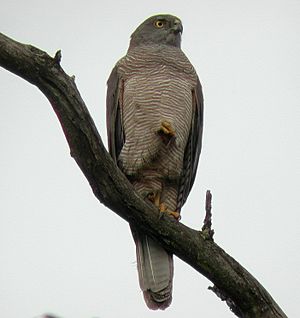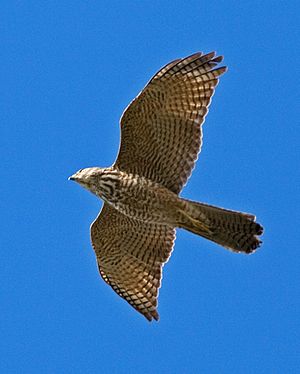Brown goshawk facts for kids
Quick facts for kids Brown goshawk |
|
|---|---|
 |
|
| Conservation status | |
| Scientific classification | |
| Genus: |
Accipiter
|
| Species: |
fasciatus
|
The brown goshawk (scientific name: Accipiter fasciatus) is a cool, medium-sized bird of prey. It belongs to the Accipitridae family, which includes many types of hawks and eagles. You can find these amazing birds in Australia and the islands around Oceania.
Contents
What Does a Brown Goshawk Look Like?
Brown goshawks have special colors that help them blend in. Their upper parts are grey, and they have a reddish-brown collar around their neck. Their belly and chest are mostly reddish-brown with thin white stripes.
They look a bit like the collared sparrowhawk but are much bigger. Brown goshawks are known for their fast and agile flight.
Size and Weight
These birds can be about 40 to 55 centimeters (16 to 22 inches) long. Their wings can spread out from 75 to 95 centimeters (30 to 37 inches) wide! Female goshawks are usually bigger than males. An adult male might weigh around 220 grams (7.8 ounces), while a female can weigh about 355 grams (12.5 ounces).
Where Do Brown Goshawks Live?
Brown goshawks live in many places. You can find them all over Australia, in a region called Wallacea, and in New Guinea, New Caledonia, Vanuatu, and Fiji.
Their Favorite Homes
In Australia, they mostly live in eucalypt forests and woodlands. But they can also be seen in farmlands and even in cities! In the Pacific islands, they prefer to live in thick rainforests.
Long ago, brown goshawks also lived on Norfolk Island, but they are not found there anymore.
What Do Brown Goshawks Eat?
Brown goshawks are skilled hunters. They mainly eat other medium-sized birds. But they also hunt small mammals like rats and rabbits.
Hunting Grounds
These goshawks often hunt near farms or wetlands. This is because there are lots of birds there, like ducks, cockatoos, and pigeons. They also catch smaller birds such as finches, pipits, and fairy-wrens. Sometimes, they even go after bigger birds like domestic fowls or strong birds like currawongs and kookaburras.
Occasionally, they will eat Bats, small reptiles, amphibians, and even large insects.
How They Hunt
Brown goshawks use a few clever ways to catch their food:
- Still-hunting: They wait quietly on a hidden branch until a prey animal comes close enough to catch.
- Flying through bushes: They fly low through thick plants, trying to scare out small animals hiding there.
- Swooping: Sometimes, they dive down on their prey from high above.
- Chasing on foot: They can even chase small mammals on the ground!
When other birds spot a brown goshawk, smaller birds quickly fly away to hide. But bigger birds, like ravens, crows, and magpies, will often chase the goshawk away until it leaves their area.
How Do Brown Goshawks Raise Their Young?
Brown goshawks build their nests high up in tall trees. They make a platform out of sticks and twigs, and then they line it with fresh green leaves.
Eggs and Chicks
A female goshawk usually lays three eggs, but sometimes it can be two or four. The eggs hatch after about 30 days. The baby goshawks, called chicks, stay in the nest for about 31 days after hatching. Then, they are ready to fly and leave the nest.
Different Types of Brown Goshawks
Scientists have identified several different types of brown goshawks, called subspecies. These subspecies might have slight differences in their looks or where they live.
See also
 In Spanish: Azor australiano para niños
In Spanish: Azor australiano para niños



